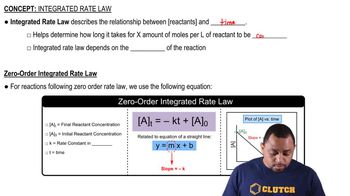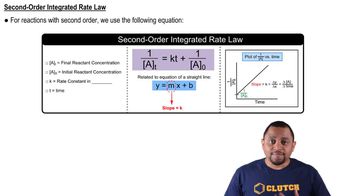Consider the tabulated data showing the initial rate of a reaction (A → products) at several different concentrations of A. What is the order of the reaction? Write a rate law for the reaction including the value of the rate constant, k.
Indicate the order of reaction consistent with each observation. a. A plot of the concentration of the reactant versus time yields a straight line. Indicate the order of reaction consistent with each observation b. The reaction has a half-life that is independent of initial concentration. c. A plot of the inverse of the concentration versus time yields a straight line.
 Verified step by step guidance
Verified step by step guidance
Verified video answer for a similar problem:
Key Concepts
Zero-Order Reactions

First-Order Reactions

Second-Order Reactions

The tabulated data were collected for this reaction: CH3Cl(g) + 3 Cl2(g) → CCl4( g) + 3 HCl(g)
Write an expression for the reaction rate law and calculate the value of the rate constant, k. What is the overall order of the reaction?
Indicate the order of reaction consistent with each observation.
a. The half-life of the reaction gets shorter as the initial concentration is increased.
b. A plot of the natural log of the concentration of the reactant versus time yields a straight line.
Indicate the order of reaction consistent with each observation c. The half-life of the reaction gets longer as the initial concentration is increased.
The tabulated data show the concentration of AB versus time for this reaction: AB( g)¡A( g) + B( g) Time (s) [AB] (M) 0 0.950 50 0.459 100 0.302 150 0.225 200 0.180 250 0.149 300 0.128 350 0.112 400 0.0994 450 0.0894 500 0.0812 Determine the order of the reaction and the value of the rate constant. Predict the concentration of AB at 25 s.
